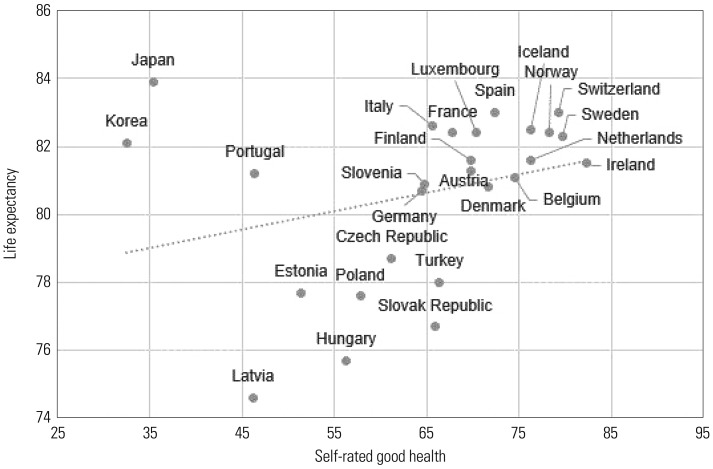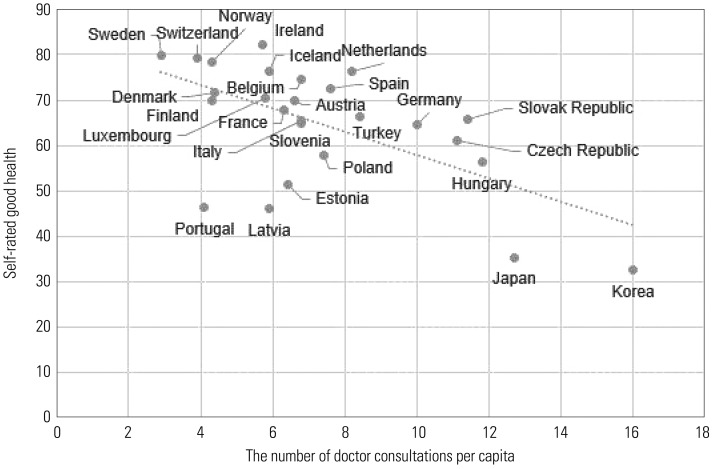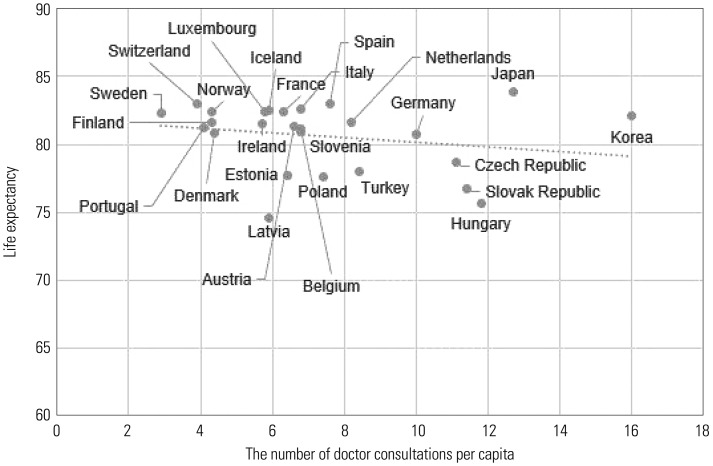Yonsei Med J.
2019 Oct;60(10):998-1003. 10.3349/ymj.2019.60.10.998.
Why Do Japan and South Korea Record Very Low Levels of Perceived Health Despite Having Very High Life Expectancies?
- Affiliations
-
- 1Institute of Health Policy and Management, Medical Research Center, Seoul National University, Seoul, Korea. yhkhang@snu.ac.kr
- 2Department of Health Policy and Management, Seoul National University College of Medicine, Seoul, Korea.
- KMID: 2459154
- DOI: http://doi.org/10.3349/ymj.2019.60.10.998
Abstract
- Japan and Korea follow a unique trend in which, despite reporting two of the highest life expectancies (LEs) among the Organization for Economic Co-operation and Development (OECD) countries, the proportion of people with good self-rated health (SRH) is disproportionately low. We sought to explain this high-LE-low-SRH paradox by examining associations among LE, the prevalence of good SRH, and healthcare utilization. Our hypothesis was that countries with more frequent healthcare use would demonstrate poorer SRH and that SRH would not show a meaningful association with LE among developed countries. This study extracted data from Health at a Glance 2017 by the OECD for 26 countries with valid and comparable information on LE, SRH, and the number of doctor consultations per capita. Correlations among LE, good SRH, and number of doctor consultations per capita were analyzed. The number of annual doctor consultations per capita and the prevalence of good SRH were closely correlated (correlation coefficient=−0.610); excluding outliers produced a higher correlation coefficient (−0.839). Similar patterns were observed when we replaced good SRH with poor SRH. Meanwhile, the correlation coefficient between annual per capita doctor consultations and LE was quite low (−0.216). Although good SRH is closely related to better LE at the individual level, this was not true at the national level. Frequent use of healthcare in Japan and Korea was strongly correlated with poorer SRH, without any meaningful correlation with LE.
MeSH Terms
Figure
Reference
-
1. Organization for Economic Cooperation and Development (OECD). Health at a glance 2017: OECD Indicators [Internet]. Paris: OECD Publishing;c2017. accessed on 2018 August 17. Available at:. DOI: 10.1787/health_glance-2017-en.2. World Bank. Life expectancy at birth, total (years) [Internet]. Washington DC: The World Bank Group;c2018. accessed on 2018 August 23. Available at: https://data.worldbank.org/indicator/sp.dyn.le00.in.3. Kontis V, Bennett JE, Mathers CD, Li G, Foreman K, Ezzati M. Future life expectancy in 35 industrialised countries: projections with a Bayesian model ensemble. Lancet. 2017; 389:1323–1335. PMID: 28236464.
Article4. Yonhap News. S. Koreans negative about their health: OECD report. Yonhap News;2017. 9. 22. accessed on 2018 August 24. Available at: http://english.yonhapnews.co.kr/news/2017/09/22/0200000000AEN20170922002900320.html?did=2106m.5. Organization for Economic Cooperation and Development (OECD). How's life in Japan? [Internet]. Paris: OECD Publishing;c2017. accessed on 2018 August 24. Available at: https://www.oecd.org/statistics/Better-Life-Initiative-country-note-Japan.pdf.7. Bilgel F, Karahasan BC. Self-rated health and endogenous selection into primary care. Soc Sci Med. 2018; 197:168–182. PMID: 29247899.
Article8. Demirchyan A, Thompson ME. Determinants of self-rated health in women: a population-based study in Armavir Marz, Armenia, 2001 & 2004. Int J Equity Health. 2008; 7:25. PMID: 19077263.
Article9. Smith PM, Glazier RH, Sibley LM. The predictors of self-rated health and the relationship between self-rated health and health service needs are similar across socioeconomic groups in Canada. J Clin Epidemiol. 2010; 63:412–421. PMID: 19926448.
Article10. Breidablik HJ, Meland E, Lydersen S. Self-rated health during adolescence: stability and predictors of change (Young-HUNT study, Norway). Eur J Public Health. 2009; 19:73–78. PMID: 19022851.
Article11. Ahn HS, Welch HG. South Korea's thyroid-cancer “Epidemic”--turning the tide. N Engl J Med. 2015; 373:2389–2390. PMID: 26650173.12. Shinagawa T, Kitamura T, Katanoda K, Matsuda T, Ito Y, Sobue T. The incidence and mortality rates of neuroblastoma cases before and after the cessation of the mass screening program in Japan: a descriptive study. Int J Cancer. 2017; 140:618–625. PMID: 27778323.
Article13. Chen C, Lee SY, Stevenson HW. Response style and cross-cultural comparisons of rating scales among East Asian and North American students. Psychol Sci. 1995; 6:170–175.
Article14. Lee JW, Jones PS, Mineyama Y, Zhang XE. Cultural differences in responses to a Likert scale. Res Nurs Health. 2002; 25:295–306. PMID: 12124723.
Article15. McCurry J. South Korea's inequality paradox: long life, good health and poverty. The Guardian;2017. 8. 02. accessed on 2018 October 15. Available at: https://www.theguardian.com/inequality/2017/aug/02/south-koreas-inequality-paradox-long-life-good-health-and-poverty.16. Otake T. Suicides down, but Japan still second highest among major industrialized nations, report says. The Japan Times;2017. 5. 30. accessed on 2018 August 24. Available at: https://www.japantimes.co.jp/news/2017/05/30/national/social-issues/preventive-efforts-seen-helping-2016-saw-another-decline-suicides-japan-21897/#.XGlnuPZuI98.17. Organization for Economic Cooperation and Development (OECD). Poverty rate [Internet]. Paris: OECD Publishing;c2018. accessed on 2018 August 24. Available at: https://data.oecd.org/inequality/poverty-rate.htm.18. Khang YH, Lynch JW, Yun S, Lee SI. Trends in socioeconomic health inequalities in Korea: use of mortality and morbidity measures. J Epidemiol Community Health. 2004; 58:308–314. PMID: 15026444.
Article19. Baker JL, van der Gaag J. Equity in health care and health care financing: evidence from five developing countries. In : van Doorslaer E, Wagstaff A, Rutten F, editors. Equity in the finance and delivery of health care: an international perspective. Oxford: Oxford University Press;1993. p. 356–394.20. Murray CJ, Chen LC. Understanding morbidity change. The Population and Development Review. 1992; 18:481–503.
Article21. Wagstaff A. Social health insurance vs. tax-financed health systems-evidence from the OECD [Internet]. Washington DC: The World Bank Group;c2009. accessed on 2019 February 1. Available at: http://documents.worldbank.org/curated/en/545121468028868365/Social-health-insurance-vs-tax-financed-health-systems-evidence-from-the-OECD.22. Idler EL, Benyamini Y. Self-rated health and mortality: a review of twenty-seven community studies. J Health Soc Behav. 1997; 38:21–37. PMID: 9097506.
Article23. Khang YH, Kim HR. Gender differences in self-rated health and mortality association: role of pain-inducing musculoskeletal disorders. J Womens Health (Larchmt). 2010; 19:109–116. PMID: 20088666.
Article24. DeSalvo KB, Bloser N, Reynolds K, He J, Muntner P. Mortality prediction with a single general self-rated health question. A metaanalysis. J Gen Intern Med. 2006; 21:267–275. PMID: 16336622.
- Full Text Links
- Actions
-
Cited
- CITED
-
- Close
- Share
- Similar articles
-
- Perceived Environmental Pollution and Its Impact on Health in China, Japan, and South Korea
- A Comparative Study on a Health Promoting Lifestyle and Perceived Health Status between High and Low Income Elderly
- The Effects of Digital Literacy and Health Empowerment on Elders' Communication with Doctors: Focusing on Moderating Effect of Health Beliefs
- Associations of Ambient Air Pollutant Concentrations With Respiratory Symptoms and Perceived Health Status in Japanese Adults With and Without Chronic Respiratory Diseases: A Panel Study
- Effects of Rhythmic Exercise Program on the Perceived Health Status, Depression, Life Satisfaction and Physical Strength in Elderly




